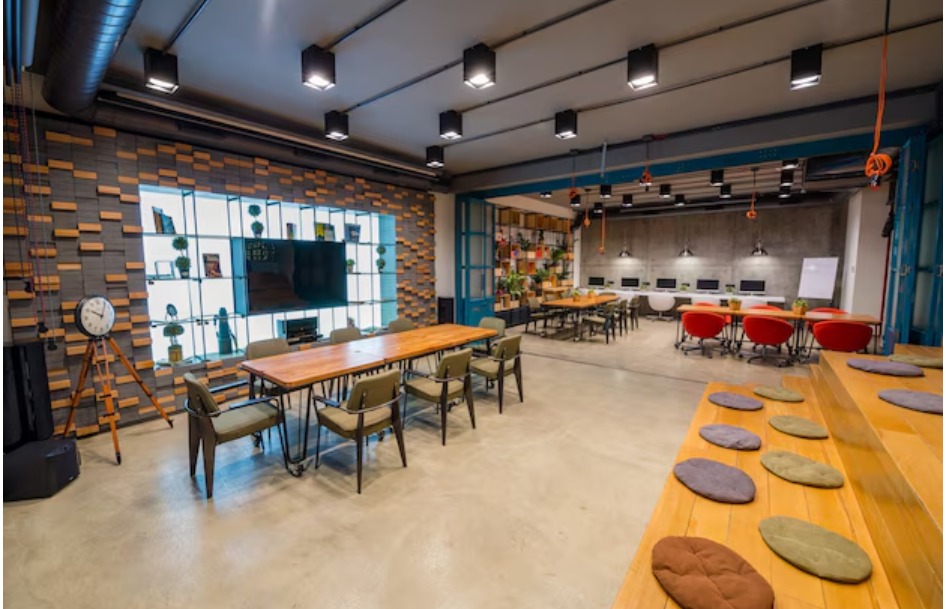How Will Technology Shape the Future of Workplace Design?

With the rapid progress of technology, the modern business environment is constantly evolving, leading to significant transformations in the workplace. As organizations strive to optimize productivity, foster collaboration, and enhance employee well-being, the role of technology in shaping the future of workplace design has become increasingly significant. In this blog, we will talk about the innovative ways in which technology is reshaping the traditional office environment and redefining the concept of workplace design.
At Advance India Projects Limited Signature , (AIPL Signature) we redefine workplace design with innovation and excellence. Our Grade 'A' office spaces seamlessly blend with street-level retail, fostering a dynamic environment where businesses and employees thrive. Designed for optimal work-life balance, it emphasizes employee comfort, convenience, and wellness, setting new standards in workplace design. This development positions itself as a leading destination for businesses seeking a modern, technologically advanced space that promotes productivity and collaboration.
Table of Contents
1. The Future of Workplace Design
2. The Impact of Artificial Intelligence
3. Conclusion
4. Disclaimer
The Future of Workplace Design
1. Embracing Smart Office Solutions
One of the most notable trends in workplace design is the integration of smart office solutions powered by cutting-edge technologies. From IoT (Internet of Things) sensors to advanced automation systems, smart offices are revolutionizing the way we interact with physical workspaces. These technologies enable seamless connectivity, allowing employees to control lighting, temperature, and other environmental factors with the touch of a button or even voice commands. By leveraging data analytics and machine learning algorithms, smart office systems can optimize energy usage, enhance comfort levels, and create personalized experiences for employees.
2. Flexible and Agile Workspaces
Another key aspect of technology-driven workplace design is the emergence of flexible and agile workspaces. Traditional cubicles and fixed desks are giving way to open-plan layouts that encourage collaboration, creativity, and flexibility. Thanks to advancements in mobile technology and cloud computing, employees are no longer tethered to their desks but can work from anywhere within the office premises. Modular furniture, movable partitions, and versatile meeting spaces are becoming the norm, allowing organizations to adapt quickly to changing business needs and accommodate diverse work styles.
3. Virtual Collaboration and Remote Work
The rise of virtual collaboration tools and remote work technologies is also reshaping the future of workplace design. With the advent of video conferencing, project management platforms, and virtual reality (VR) tools, teams can collaborate effectively across geographic boundaries without the need for physical presence. As remote work becomes increasingly prevalent, organizations are rethinking the design of their office spaces to prioritize collaboration zones, huddle rooms, and interactive technology hubs where virtual teams can connect and brainstorm ideas in real-time.
4. Enhanced Employee Experience
Furthermore, technology is playing a vital role in enhancing the overall employee experience within the workplace. From personalized wellness apps to AI-powered virtual assistants, innovative technologies are empowering employees to stay productive, engaged, and healthy. For instance, wearable devices and biometric sensors can provide valuable insights into employee well-being, allowing organizations to design workspaces that promote physical fitness, mindfulness, and work-life balance. By harnessing the power of data and analytics, employers can create tailored experiences that cater to the individual needs and preferences of their workforce.
The Impact of Artificial Intelligence
Artificial intelligence (AI) is poised to revolutionize workplace design in ways that were once unimaginable. Here are key points illustrating its transformative potential:
1. Data Analysis and Prediction
AI algorithms process extensive amounts of data to predict future trends and patterns in workplace behavior and utilization.
2. Optimized Space Utilization
AI-driven insights enable organizations to optimize space utilization by identifying underutilized areas and recommending adjustments.
3. Efficient Resource Allocation
AI algorithms help in efficient allocation of resources such as desks, meeting rooms, and amenities based on real-time usage data.
4. Enhanced Layout and Flow
AI-powered space planning software generates optimal office layouts considering factors like employee proximity, departmental interactions, and traffic patterns.
5. Maximized Productivity
Optimized office layouts and efficient resource allocation contribute to a conducive work environment, boosting employee productivity.
6. Continuous Improvement
AI algorithms continuously learn from data feedback, allowing for ongoing refinement and optimization of workplace design strategies.
Conclusion
In conclusion, the future of workplace design is being shaped by technology in profound and transformative ways. From smart office solutions and flexible workspaces to virtual collaboration tools and AI-driven insights, technology is enabling organizations to create environments that inspire creativity, foster innovation, and enhance employee well-being. As we embrace the digital age and adapt to new ways of working, the role of technology in shaping the future of workplace design will continue to evolve, driving positive change and redefining the way we experience the modern workplace.
AIPL Signature is acknowledged for its innovative integration of technology in workspace design, positioning it as a competitive option among modern office spaces. With their commitment to innovation, sustainability, and employee-centric design principles, they strive to create environments that inspire productivity, foster collaboration, and promote well-being.
Disclaimer
This content is provided for informational purposes only and is not intended as an advertisement, financial advice, or real estate advice. The views expressed herein are the author's own and do not necessarily reflect the views of AIPL. While every effort has been made to ensure the accuracy and completeness of this information, circumstances can change, and the information may become outdated. We recommend consulting with a professional advisor before making any real estate decisions. References to specific properties, investments, or locations are for illustrative purposes only and should not be considered an endorsement or recommendation. AIPL Group and its directors, subsidiaries, officers, employees, agents, affiliates, and partners, are not liable for any consequence of any action taken by the viewer relying on such material/ information on this blogpost.


